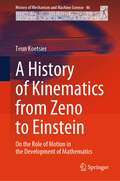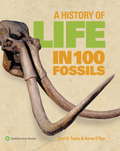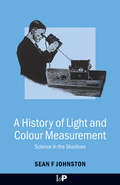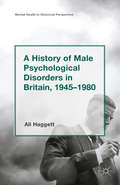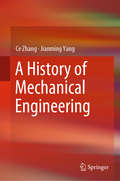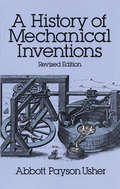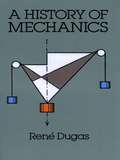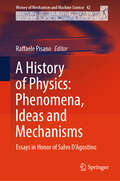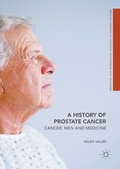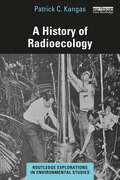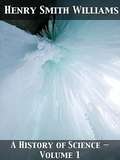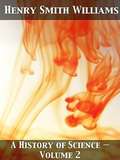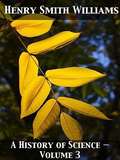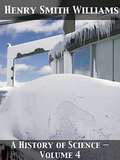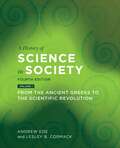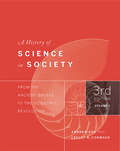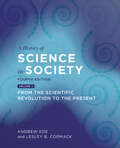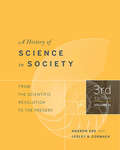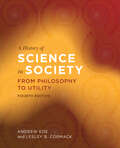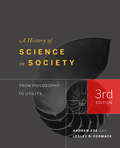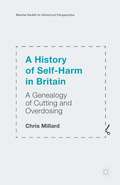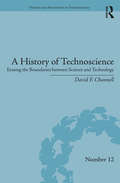- Table View
- List View
A History of Italian Wine: Culture, Economics, and Environment in the Nineteenth through Twenty-First Centuries
by Paolo Tedeschi Manuel Vaquero Piñeiro Luciano MaffiThis book analyzes the evolution of Italian viticulture and winemaking from the 1860s to the new Millennium. During this period the Italian wine sector experienced a profound modernization, renovating itself and adapting its products to international trends, progressively building the current excellent reputation of Italian wine in the world market.Using unpublished sources and a vast bibliography, authors highlight the main factors favoring this evolution: public institutional support to viticulture; the birth and the growth of Italian wine entrepreneurship; the improvement in quality of the winemaking processes; the increasing relevance of viticulture and winemaking in Italian agricultural production and export; and the emergence of wine as a cultural product.
A History of Kinematics from Zeno to Einstein: On the Role of Motion in the Development of Mathematics (History of Mechanism and Machine Science #46)
by Teun KoetsierThis book covers the history of kinematics from the Greeks to the 20th century. It shows that the subject has its roots in geometry, mechanics and mechanical engineering and how it became in the 19th century a coherent field of research, for which Ampère coined the name kinematics. The story starts with the important Greek tradition of solving construction problems by means of kinematically defined curves and the use of kinematical models in Greek astronomy. As a result in 17th century mathematics motion played a crucial role as well, and the book pays ample attention to it. It is also discussed how the concept of instantaneous velocity, unknown to the Greeks, etc was introduced in the late Middle Ages and how in the 18th century, when classical mechanics was formed, kinematical theorems concerning the distribution of velocity in a solid body moving in space were proved. The book shows that in the 19th century, against the background of the industrial revolution, the theory of machines and thus the kinematics of mechanisms received a great deal of attention. In the final analysis, this led to the birth of the discipline.
A History of Life in 100 Fossils
by Paul D. Taylor Aaron O'DeaA History of Life in 100 Fossils showcases 100 key fossils that together illustrate the evolution of life on earth. Iconic specimens have been selected from the renowned collections of the two premier natural history museums in the world, the Smithsonian Institution, Washington, and the Natural History Museum, London. The fossils ahve been chosen not only for their importance in the history of life, but also because of the visual story they tell. This stunning book is perfect for all readers because its clear explanations and beautiful photographs illuminate the significance of these amazing pieces, including 500 million-year-old Burgess Shale fossils that provide a window into early animal life in the sea, insects encapsulated by amber, the first fossil bird Archaeopteryx, and the remains of our own ancestors.
A History of Light and Colour Measurement: Science in the Shadows
by Sean F. Johnston2003 Paul Bunge Prize of the Hans R. Jenemann Foundation for the History of Scientific InstrumentsJudging the brightness and color of light has long been contentious. Alternately described as impossible and routine, it was beset by problems both technical and social. How trustworthy could such measurements be? Was the best standard of inten
A History of Male Psychological Disorders in Britain, 1945-1980 (Mental Health in Historical Perspective)
by Alison HaggettThis book is open access under a CC BY license and explores the under-researched history of male mental illness from the mid-twentieth century. It argues that statistics suggesting women have been more vulnerable to depression and anxiety are misleading since they underplay a host of alternative presentations of 'distress' more common in men.
A History of Mechanical Engineering
by Jianming Yang Ce ZhangThis book explores the history of mechanical engineering since the Bronze Age. Focusing on machinery inventions and the development of mechanical technology, it also discusses the machinery industry and modern mechanical education. The evolution of machinery is divided into three stages: Ancient (before the European Renaissance), Modern (mainly including the two Industrial Revolutions) and Contemporary (since the Revolution in Physics, especially post Second World War). The book not only clarifies the development of mechanical engineering, but also reveals the driving forces behind it – e.g. the economy, national defense and human scientific research activities – to highlight the links between technology and society; mechanical engineering and the natural sciences; and mechanical engineering and related technological areas.Though mainly intended as a textbook or supplemental reading for graduate students, the book also offers a unique resource for researchers and engineers in mechanical engineering who wish to broaden their horizons.
A History of Mechanical Inventions: Revised Edition
by Abbott Payson Usher"The book is without peer in its field." -- American ScientistIn this completely revised and enlarged edition of a classic work in the history of technology, a noted scholar explores the importance of technological innovation in the cultural and economic history of the West.Following an introductory discussion of the place of technology in economic history, the author offers a penetrating historical analysis of social change. Within this context he develops a theory of invention based on Gestalt psychology and a concept of social evolution as continuous development from antiquity to the present. Emphasis is placed on the role of economic forces in the development of technology, with scientific concepts also playing an important role in bringing about change.The latter part of the book focuses on the production and control of power in general, and in particular on a number of important operative mechanisms. Thus we read thought-provoking accounts of the technology of textile manufacture from primitive times, of water wheels and windmills, water clocks, and mechanical clocks, and the work of Leonardo da Vinci. The development of printing is carefully studied, not only for its intrinsic interest, but because of its importance for the history of science. Other topics include the production and application of power (1500-1830), machine tools and quantity production, the production and distribution of power since 1832, and the role of Asia Minor as a source of techniques which dominated the Middle Ages and the modern period as well.Thoroughly researched and cogently reasoned, A History of Mechanical Inventions belongs in the library of anyone interested in the history of science and invention, as well as the relationship of technology to economic and social history."Throughout the book there is constant proof of the author's wide learning and varied intellectual interests." -- The New York Times
A History of Mechanics
by René DugasIn this masterful synthesis and summation of the science of mechanics, Rene Dugas, a leading scholar and educator at the famed Ecole Polytechnique in Paris, deals with the evolution of the principles of general mechanics chronologically from their earliest roots in antiquity through the Middle Ages to the revolutionary developments in relativistic mechanics, wave and quantum mechanics of the early 20th century.The present volume is divided into five parts: The first treats of the pioneers in the study of mechanics, from its beginnings up to and including the sixteenth century; the second section discusses the formation of classical mechanics, including the tremendously creative and influential work of Galileo, Huygens and Newton. The third part is devoted to the eighteenth century, in which the organization of mechanics finds its climax in the achievements of Euler, d'Alembert and Lagrange. The fourth part is devoted to classical mechanics after Lagrange. In Part Five, the author undertakes the relativistic revolutions in quantum and wave mechanics.Writing with great clarity and sweep of vision, M. Dugas follows closely the ideas of the great innovators and the texts of their writings. The result is an exceptionally accurate and objective account, especially thorough in its accounts of mechanics in antiquity and the Middle Ages, and the important contributions of Jordanus of Nemore, Jean Buridan, Albert of Saxony, Nicole Oresme, Leonardo da Vinci, and many other key figures.Erudite, comprehensive, replete with penetrating insights, AHistory of Mechanics is an unusually skillful and wide-ranging study that belongs in the library of anyone interested in the history of science.
A History of Physics: Essays in Honor of Salvo D'Agostino (History of Mechanism and Machine Science #42)
by Raffaele PisanoThe book gathers several contributions by historians of physics, philosophers of science and scientists as new essays in the history of physics ranging across the entire field, related in most instances to the works of Salvo D'Agostino (1921-2020), one of the field's most prominent scholars since the second half of the past century. A phenomenon is an observable measurable fact, including data modelling, assumptions/laws. A mechanical phenomenon is associated to equilibrium/motion. Are all mechanisms mechanisms of a phenomenon? Scholars with different backgrounds discuss mechanism/phenomena from an historical point of view. The book is also devoted to understanding of causations of disequilibrium (shock, gravitational, attraction/repulsion, inertia, entropy, etc.), including changes/interaction in the framework of irregular cases of modern physics as well. The book is an accessible avenue to understanding phenomena, ideas and mechanisms by leading authorities who offer much-needed historical insights into the field and on the relationship Physics–Mathematics. It provides an absorbing and revealing read for historians, philosophers and scientists alike.
A History of Prostate Cancer: Cancer, Men and Medicine (Medicine and Biomedical Sciences in Modern History)
by Helen ValierThis book offers a comprehensive and inclusive insight into the history of prostate cancer and its sufferers. Until recently, little practical help could be offered for men afflicted with the devastating diseases of the genitourinary organs. This is despite complaints of painful urination from aging men being found in ancient medical manuscripts, despite the anatomical discoveries of the European Renaissance and despite the experimental surgical researches of the eighteen and nineteenth centuries. As diseases of the prostate, including prostate cancer, came to be better understood in the early twentieth century, therapeutic nihilism continued as curative radical surgeries and radiotherapy failed. The therapeutic 'turn' came with hormonal therapies, itself a product of the explosive growth of U. S. biomedicine from the 1940s onwards. By the 1990s, prostate cancer screening had become a somewhat ubiquitous but controversial feature of the medical encounter for American men as they aged, which greatly influenced the treatment pathways and identity of the male patient: as victim, as hero, and ultimately, as consumer.
A History of Radioecology (Routledge Explorations in Environmental Studies)
by Patrick C. KangasThis book presents a history of radioecology, from World War II through to the critical years of the Cold War, finishing with a discussion of recent developments and future implications for the field. Drawing on a vast array of primary sources, the book reviews, synthesizes and discusses the implications of the ecological research supported by the Atomic Energy Commission (AEC) of the United States government, from World War II to the early 1970s. This was a critical period in the history of ecology, characterized by a transition from the older, largely descriptive studies of communities of plants and animals to the modern form of the science involving functional studies of energy flow and mineral cycling in ecosystems. This transition was in large part due to the development of radioecology, which was a by-product of the Cold War and the need to understand and predict the consequences of a nuclear war that was planned but has never occurred. The book draws on important case studies, such as the Pacific Proving Grounds, the Nevada Test Site, El Verde in Puerto Rico, the Brookhaven National Laboratory and recent events such as the nuclear disasters at Chernobyl and Fukushima. By revisiting studies and archived information from the Cold War era, this book offers lessons from the history of radioecology to provide background and perspective for understanding possible present-day impacts from issues of radiation risks associated with nuclear power generation and waste disposal. Post-Cold War developments in radioecology will be also reviewed and contrasted with the AEC-supported ecology research for further perspectives. This book will be of great interest to students and scholars of radioecology, environmental pollution, environmental technology, bioscience and environmental history.
A History of Science -- Volume 1
by Henry Smith Williams Edward Huntington WilliamsShould the story that is about to be unfolded be found to lack interest, the writers must stand convicted of unpardonable lack of art. <P> <P> Nothing but dulness in the telling could mar the story, for in itself it is the record of the growth of those ideas that have made our race and its civilization what they are; of ideas instinct with human interest, vital with meaning for our race; fundamental in their influence on human development; part and parcel of the mechanism of human thought on the one hand, and of practical civilization on the other. Such a phrase as “fundamental principles” may seem at first thought a hard saying, but the idea it implies is less repellent than the phrase itself, for the fundamental principles in question are so closely linked with the present interests of every one of us that they lie within the grasp of every average man and woman— nay, of every well-developed boy and girl. These principles are not merely the stepping-stones to culture, the prerequisites of knowledge— they are, in themselves, an essential part of the knowledge of every cultivated person
A History of Science -- Volume 2
by Henry Smith Williams Edward Huntington WilliamsThe studies of the present book cover the progress of science from the close of the Roman period in the fifth century A. D. to about the middle of the eighteenth century. In tracing the course of events through so long a period, a difficulty becomes prominent which everywhere besets the historian in less degree— a difficulty due to the conflict between the strictly chronological and the topical method of treatment. <P> <P> We must hold as closely as possible to the actual sequence of events, since, as already pointed out, one discovery leads on to another. But, on the other hand, progressive steps are taken contemporaneously in the various fields of science, and if we were to attempt to introduce these in strict chronological order we should lose all sense of topical continuity.
A History of Science -- Volume 3
by Henry Smith Williams Edward Huntington WilliamsWith the present book we enter the field of the distinctively modern. There is no precise date at which we take up each of the successive stories, but the main sweep of development has to do in each case with the nineteenth century. <P> <P> We shall see at once that this is a time both of rapid progress and of great differentiation. We have heard almost nothing hitherto of such sciences as paleontology, geology, and meteorology, each of which now demands full attention. Meantime, astronomy and what the workers of the elder day called natural philosophy become wonderfully diversified and present numerous phases that would have been startling enough to the star-gazers and philosophers of the earlier epoch.
A History of Science -- Volume 4
by Henry Smith Williams Edward Huntington WilliamsAS regards chronology, the epoch covered in the present volume is identical with that viewed in the preceding one. But now as regards subject matter we pass on to those diverse phases of the physical world which are the field of the chemist, and to those yet more intricate processes which have to do with living organisms. <P> <P> So radical are the changes here that we seem to be entering new worlds; and yet, here as before, there are intimations of the new discoveries away back in the Greek days. The solution of the problem of respiration will remind us that Anaxagoras half guessed the secret; and in those diversified studies which tell us of the Daltonian atom in its wonderful transmutations, we shall be reminded again of the Clazomenian philosopher and his successor Democritus.
A History of Science in Society, Volume I: From Philosophy to Utility, Fourth Edition
by Lesley B. Cormack Andrew EdeIn A History of Science in Society, Ede and Cormack trace the history of the changing place of science in society and explore the link between the pursuit of knowledge and the desire to make that knowledge useful. Volume I covers the origins of natural philosophy in the ancient world to the scientific revolution. The fourth edition of this bestselling textbook adds content on non-Western science and a new "Connections" case study feature on the scientist and poet Omar Khayyam. The text is accompanied by over fifty images and maps that illustrate key developments in the history of science. Essay questions, chapter timelines, a further readings section, and an index provide additional support for students.
A History of Science in Society, Volume I: From The Ancient Greeks To The Scientific Revolution, Third Edition
by Lesley B. Cormack Andrew EdeA History of Science in Society is a concise overview that introduces complex ideas in a non-technical fashion. Ede and Cormack trace the history of the changing place of science in society and explore the link between the pursuit of knowledge and the desire to make that knowledge useful. Volume I covers the origins of natural philosophy in the ancient world to the Scientific Revolution. New topics in this edition include astronomy and mathematics in ancient Mayan society, science and technology in ancient India and China, and Islamic cartography. New "Connections" features provide in-depth exploration of the ways science and society interconnect. The text is accompanied by 27 colour maps and diagrams, and 4 colour plates highlighting key concepts and events. Essay questions, chapter timelines, a further readings section, and an index provide additional support for students. A companion reader edited by the authors, A History of Science in Society: A Reader, is also available.
A History of Science in Society, Volume II: From Philosophy to Utility, Fourth Edition
by Lesley B. Cormack Andrew EdeIn A History of Science in Society, Ede and Cormack trace the history of the changing place of science in society and explore the link between the pursuit of knowledge and the desire to make that knowledge useful. Volume II covers the period from the scientific revolution to the present day. The fourth edition of this bestselling textbook brings the narrative right up into the twenty-first century by incorporating the COVID-19 pandemic. The edition also adds content on Indigenous and non-Western science as well as three new "Connections" case study features. The text is accompanied by over sixty images and maps that illustrate key developments in the history of science. Essay questions, chapter timelines, a further readings section, and an index provide additional support for students.
A History of Science in Society, Volume II: From the Scientific Revolution to the Present, Third Edition
by Lesley B. Cormack Andrew EdeA History of Science in Society is a concise overview that introduces complex ideas in a non-technical fashion. Ede and Cormack trace the history of the changing place of science in society and explore the link between the pursuit of knowledge and the desire to make that knowledge useful. Volume II covers from the Scientific Revolution until the present day. New topics in this edition include science and the corporate world, the regulation of science and technology, and climate change. New "Connections" features provide in-depth exploration of the ways science and society interconnect. The text is accompanied by 38 colour maps and diagrams, and 4 colour plates highlighting key concepts and events. Essay questions, chapter timelines, a further readings section, and an index provide additional support for students. A companion reader edited by the authors, A History of Science in Society: A Reader, is also available.
A History of Science in Society: From Philosophy to Utility, Fourth Edition
by Lesley B. Cormack Andrew EdeIn A History of Science in Society, Ede and Cormack trace the history of the changing place of science in society and explore the link between the pursuit of knowledge and the desire to make that knowledge useful. The fourth edition of this bestselling textbook brings the narrative right up to the present day by incorporating the COVID-19 pandemic. The edition also adds content on Indigenous and non-western science as well as five new "Connections" case study features, including one on the scientist and poet Omar Khayyam. The text is accompanied by 100 images and maps and a colour insert showing off key moments in the history of science. Essay questions, chapter timelines, a further readings section, and an index provide additional support for students.
A History of Science in Society: From Philosophy to Utility, Third Edition
by Lesley Cormack Andrew EdeA History of Science in Society is a concise overview that introduces complex ideas in a non-technical fashion. Ede and Cormack trace the history of the changing place of science in society and explore the link between the pursuit of knowledge and the desire to make that knowledge useful.New topics in this edition include astronomy and mathematics in ancient Mayan society, science and technology in ancient India and China, and Islamic cartography. New "Connections" features provide in-depth exploration of the ways science and society interconnect. The text is accompanied by 55 colour maps and diagrams, and 8 colour plates highlighting key concepts and events. Essay questions, chapter timelines, a further readings section, and an index provide additional support for students. A companion reader edited by the authors, A History of Science in Society: A Reader, is also available.
A History of Seeing in Eleven Inventions: A History of Seeing
by Tristan Gooley Susan Denham Wade'A remarkable achievement' - Stephen FryIn 2015 #thedress captured the world’s imagination. Was the dress in the picture white and gold or blue and black? It inspired the author to ask: if people in the same time and place can see the same thing differently, how did people in distant times and places see the world?Jam-packed with fascinating stories, facts and insights and impeccably researched, A History of Seeing in Eleven Inventions investigates the story of seeing from the evolution of eyes 500 million years ago to the present day. Time after time, it reveals, inventions that changed how people saw the world ended up changing it altogether.Twenty-first-century life is more visual than ever, and seeing overwhelmingly dominates our senses.Can our eyes keep up with technology? Have we gone as far as the eye can see?
A History of Self-Harm in Britain: A Genealogy of Cutting and Overdosing (Mental Health in Historical Perspective)
by Chris MillardThis book is open access under a CC BY license and charts the rise and fall of various self-harming behaviours in twentieth-century Britain. It puts self-cutting and overdosing into historical perspective, linking them to the huge changes that occur in mental and physical healthcare, social work and wider politics.
A History of Technoscience: Erasing the Boundaries between Science and Technology (History and Philosophy of Technoscience)
by David F. ChannellAre science and technology independent of one another? Is technology dependent upon science, and if so, how is it dependent? Is science dependent upon technology, and if so how is it dependent? Or, are science and technology becoming so interdependent that the line dividing them has become totally erased? This book charts the history of technoscience from the late nineteenth century to the end of the twentieth century and shows how the military–industrial–academic complex and big science combined to create new examples of technoscience in such areas as the nuclear arms race, the space race, the digital age, and the new worlds of nanotechnology and biotechnology.
A History of Weapons: Crossbows, Caltrops, Catapults & Lots of Other Things that Can Seriously Mess You Up
by John O'Bryan“[A] menacingly illustrated book . . . nerdily gushes over the design and use of 130+ historical instruments of combat.” —ThrillistOne day a prehistoric guy picked up a rock and threw it at something. And the history of weapons began. Comedy writer and weapon nerd John O’Bryan relays the freaky highlights of man’s centuries-old obsession with weaponry. He hilariously explains the mace, the morning star, and the man catcher, while conveying factual information about each weapon: its history, uses, and badass potential. Looking through history’s highlights, readers will learn about Attila the Hun, Genghis Khan, and the “peaceful” Shaolin monks. This ultimate compendium of awesome weapons delivers all the surprisingly true details sure to impress anybody who’s ever made a gun with their fingers and said, “PEW-PEW-PEW!”“[A] comic breakdown of weaponry.” —Lost in a Supermarket

